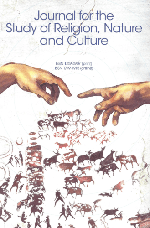2017 – Mountains and Sacred Landscapes | The New School, New York City (April 20-23, 2017)
See highlight photos from the conference here.
We had 225 attendees from over 25 countries (every continent was represented [except Antarctica!]), 39 sessions of panels, papers, roundtables, and alternative formats, six keynote or plenary sessions, and other special events.
For those of you who were unable to join us, some of the conference highlights included our banquet, during which we celebrated Bron Taylor’s Lifetime Achievement Award, with a moving talk by Taylor about his career and the early roots of the ISSRNC, and launched our first student paper award, which went to Lily Zeng for her paper, Problematizing Ideas of “Purity” and “Timelessness” in the Conservation Narratives of Sacred Groves; a field trip to the Rubin Museum for presentations by curators on “Sacred Landscapes in the Himalayas”; a book launch featuring three new books (monographs by James Miller and Georgina Drew and a collection of essays edited by ICI Fellows Jayanta Bandyopadhyay, Sanjay Chaturvedi, and Dong Shikui); and six keynotes, performances, or plenary sessions and special presentations by the India China Institute’s Sacred Himalaya Initiative.
You can view a digital copy the conference program here or download a pdf copy below.
Featured speakers or presenters included:
Reverence for Life: Biocultural Heritage as Resistance and Restoration
 Karenna Gore
Karenna Gore
Climate change is about more than science and sustainability, it is about meaning. In the Anthropocene, the nature of humanity’s relationship to the rest of the natural world is what matters most to the continuity of the habitability of the planet. We will continue on this course of destruction or we will resist that trajectory (driven by fossil fuels, deforestation, throwaway consumerism) and prioritize the kind of balance, humility and reverence that was taught and practiced in most ancient societies, including the foundations of most faith traditions. Place-based religion and culture are important to cultivate and maintain so that we take care of the planet as a whole and replace perverse economic incentives with real regard for the most important things in life such as air, water, food and culture. Colonial religions must unravel their conceptual ties to empire— which have become entrenched within those traditions but are not intrinsic to them— and stand in solidarity with indigenous traditions. This is happening in Standing Rock and beyond and it is the most hopeful sign in the climate movement— every bit as hopeful as renewable energy and even more radical and threatening to the powers that be. It is imperative that the academy and the policy intelligentsia and religious institutions all give this movement proper regard and support— from the ground up.
Sacred Mountains: The Heights of Inspiration
Edwin Bernbaum
Using a blend of striking images, research, and personal experiences, Edwin Bernbaum explores the rich and varied symbolism of sacred mountains — from Mount Sinai in the Middle East to Mount Kailas in Tibet — showing how they express the highest values and aspirations of cultures throughout the world. Focusing on two projects he helped initiate, the presentation explores how these and other evocative mountains can enrich people’s lives and inspire efforts to conserve nature and culture. One project developed interpretive materials for US National Parks based on the spiritual and cultural associations of mountainous natural features in cultures around the world. The other is a project to nominate Mount Kailas and the pilgrimage routes leading to it as an UNESCO transboundary World Heritage Site. The presentation includes the dramatic account of an avalanche Bernbaum was caught in on Annapurna, one of the highest and most sacred peaks in the Himalaya.
Look to the Mountain-Thinking the Highest Thought
 Gregory Cajete
Gregory Cajete
Native Science is, at its core, a process for learning about life and the nature of the “spirit that moves us,” with ultimate goal of becoming fully knowledgeable about this spirit. Spirituality comes from the process of exploring and coming to know the nature of the living energy that moves in each of us, through us, and around us. This knowledge is considered completeness in its most profound form. This knowledge was gained in various places and various ways. One of the most important places to gain such knowledge was in the presence of Mountains. This presentation will explore the various ways American Indians related to the Mountains to gain knowledge of the “spirit that moves us.”
Ways of Knowing
Steve Paulson in conversation with: David Rothenberg, Georgina Drew, James Miller and Gregory Cajete




 This engaging roundtable session will feature noted WPR radio personality and To The Best of Our Knowledge host Steve Paulson in conversation with world-renown musician David Rothenberg, whose work explores the relationship between humanity and nature, indigenous scholar and professor Gregory Cajete, best known for his important work on native science, and two of our book-launch authors, Georgina Drew and James Miller. Miller’s new book is China’s Green Religion: Daoism and the Quest for a Sustainable Future (Columbia University Press, 2017). Drew’s new book is River Dialogues: Hindu Faith and the Political Ecology of Dams on the Sacred Ganga (University of Arizona Press, 2017).
This engaging roundtable session will feature noted WPR radio personality and To The Best of Our Knowledge host Steve Paulson in conversation with world-renown musician David Rothenberg, whose work explores the relationship between humanity and nature, indigenous scholar and professor Gregory Cajete, best known for his important work on native science, and two of our book-launch authors, Georgina Drew and James Miller. Miller’s new book is China’s Green Religion: Daoism and the Quest for a Sustainable Future (Columbia University Press, 2017). Drew’s new book is River Dialogues: Hindu Faith and the Political Ecology of Dams on the Sacred Ganga (University of Arizona Press, 2017).











